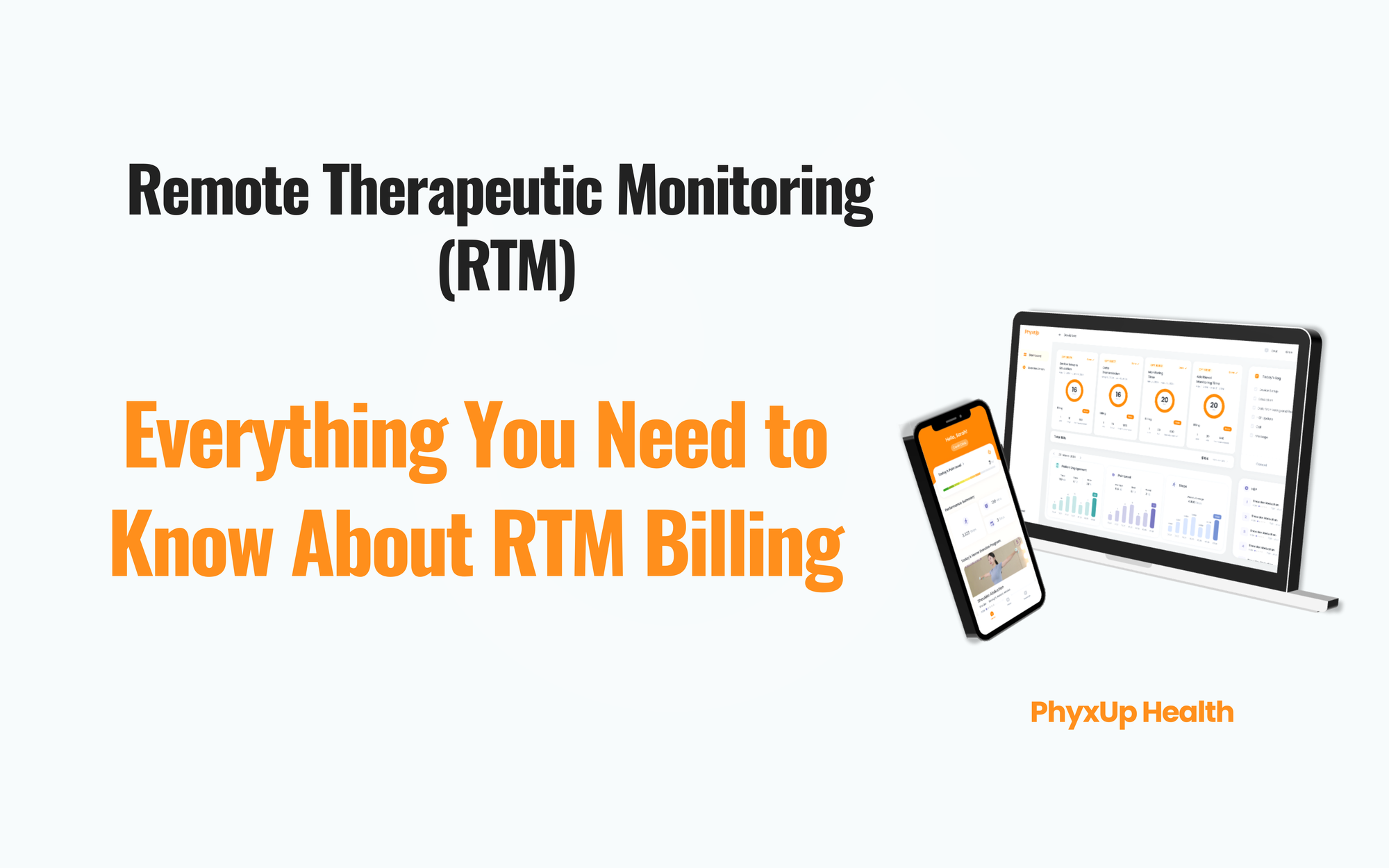What Is Remote Therapeutic Monitoring (RTM)? A Guide for PT Clinics

Imagine if you could continue supporting your patients even after they leave the clinic. That’s exactly what Remote Therapeutic Monitoring (RTM) makes possible. As physical therapists, occupational therapists, and other rehab professionals look for ways to stay connected to their patients and improve outcomes, RTM is quickly becoming one of the most practical and impactful tools available.
In this article, we’ll break down what RTM is, how it works, who can benefit, and why it’s not just a billing opportunity. It’s a smarter way to deliver care.
What Is Remote Therapeutic Monitoring (RTM)?
Remote Therapeutic Monitoring allows healthcare providers to track non-physiological data like pain levels, mobility, and home exercise progress, all from outside the clinic setting. It gives providers real-time insight into how patients are responding to their care plan, especially for musculoskeletal (MSK) and respiratory conditions.
What is Remote Therapeutic Monitoring (RTM)?
RTM vs. RPM: What’s the Difference?
RTM is often confused with Remote Patient Monitoring (RPM), but the focus is different:
| RPM | RTM |
|---|---|
| Tracks vitals like heart rate, blood pressure | Tracks symptoms, adherence, functional data |
| Often for chronic conditions like heart failure | Often for MSK or respiratory rehab |
| Requires physiological data | Requires non-physiological data |
RPM is more common in primary care and cardiology, where blood pressure, weight, and glucose levels need to be monitored daily. RTM, on the other hand, is tailor-made for outpatient therapy providers who want to understand how their care plans are being followed and how patients are feeling.
What Conditions Are Covered Under RTM?
RTM is approved for use with patients managing:
- Post-surgical rehab (knee, hip, spine)
- Chronic joint or back pain
- Arthritis and other MSK conditions
- Asthma, COPD, and chronic bronchitis
Any condition where therapy adherence and symptom tracking can impact recovery is a good fit.
Why RTM Is More Than a Billing Code
While it’s true that RTM is reimbursable (we’ll cover billing in a second), its real power lies in what it enables:
- Stronger patient engagement: Patients know their care team is still checking in.
- Earlier intervention: Real-time feedback helps catch issues before they escalate.
- Smarter decision-making: Therapists can modify plans based on real data.
- Better outcomes: Adherence improves when patients feel accountable.
- Operational efficiency: Automated tools reduce admin time and manual tracking.
How RTM Reimbursement Works
RTM is covered by Medicare and many private insurers. Here are the CPT codes most commonly used:
- 98975 – Setup and patient education (one-time)
- 98976 – Device for respiratory monitoring (monthly)
- 98977 – Device for musculoskeletal monitoring (monthly)
- 98980 – First 20 minutes of care management per month
- 98981 – Each additional 20 minutes
To bill for RTM:
- Providers must track patient data for at least 16 days in a 30-day period.
- Must provide at least 20 minutes of review and management time per calendar month.
- Data must be collected through a medical device or digital system that meets CMS requirements.
This creates a new stream of revenue for work that rehab professionals are already doing, monitoring, updating plans, and supporting patients outside the clinic.

What Devices Qualify for RTM?
RTM devices must be capable of collecting non-physiological data and transmitting it automatically to the provider. Some examples include:
- Mobile apps that track pain, mobility, or exercise completion
- Bluetooth-enabled inhalers or smart pill dispensers
- Sensors that monitor activity or respiratory function
The most effective systems are easy for patients to use and require minimal clinician input to collect and transmit data.
Why Clinics Are Adopting RTM Now
More clinics are turning to RTM because:
- It allows them to bill for care that already happens (like following up on HEPs)
- It improves patient accountability and follow-through
- It helps build more sustainable revenue streams
- It fits seamlessly into hybrid care or remote-first models
- It supports value-based care initiatives by showing measurable engagement and outcomes
And with RTM platforms like PhyxUp Health, clinics can manage it all in one place, from patient tracking to SOAP note automation to integrated billing.
What Makes PhyxUp Health Different
PhyxUp Health was founded by a physical therapist who understands the real day-to-day challenges of outpatient rehab. Our RTM platform is designed to take the administrative burden off your team while still delivering high-touch care.
We offer both self-managed and fully managed RTM options:
- Clinics can use our platform independently
- Or let our licensed PTs handle everything, check-ins, monitoring, and billing
We also provide:
- Customizable HEP video libraries
- Real-time progress dashboards
- Secure patient messaging
- Automatic CPT tracking and documentation
Whether you’re a solo practice or a multi-location clinic, our goal is to help you provide better care without adding to your workload.

Final Thoughts
RTM is more than a trend. It’s a smarter, scalable way to extend care beyond the clinic and get paid for the work you already do.
As reimbursement models shift and patient expectations grow, RTM offers a path forward that aligns clinical value with financial sustainability.
If you’re curious how RTM could fit into your clinic, or if you want to see how much revenue you might be missing, book a free walkthrough.


